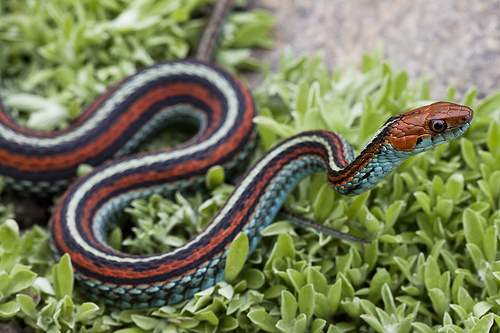
|
|
San Francisco Gartersnake - Thamnophis sirtalis tetrataeniaOverviewThis fascinating snake is a subspecies of the Common Gartersnake (Thamnophis sirtalis). It has been on the state endangered list since 1966 and was on the first Federal Endangered List established in 1973. It is a slender medium-sized snake measuring from 18-55 inches (46-140cm) with an average length of 36 inches (91cm). The head is reddish-brown with large eyes when compared to other gartersnake species. A green or turquoise dorsal stripe runs along the length of the snake and is bordered by a solid black stripe. Below the black stripe is a, usually solid but sometimes spotted, red stripe which is also bordered by a solid black stripe underneath. The belly of the snake is beautifully unique green or turquoise. The San Francisco Gartersnake is considered one of the most beautiful and rare snake species in California and possibly the United States. Habitat and RangeThis subspecies is endemic to the Bay area. Contrary to its name the San Francisco Gartersnake (SFGS) exists (and was historically found) primarily in San Mateo County. Its distribution goes from the southern county line of San Francisco at the norther end to Pt. Ano Nuevo in San Mateo County at the Southern end. Grassland and wetland near ponds, marshes, and sloughs are this species preferred environments. SFGS have the ability to survive in cold climates which are unsuitable for other species. Protected areas around the San Francisco Airport, Crystal Springs Resevoir, and similar patches of land along the San Mateo County coastline from Pacifica to Pt. Ano Nuevo are where remnant populations now exist. Large scale urbanization has been the greatest cause of range and population depletion. However, chemicals used for rodent and other pest control have added to the decrease in population size to the current number of ~1500. DietSFGS feed on a wide variety of prey such as small mammals, reptiles, amphibians and their larvae, fish, birds, eggs, worms, slugs, and even leeches. SFGS have the unique ability to consume Pacific newts which are highly poisonous to most species. Another interesting fact about their diet is that they prefer the California Red-legged frog - Rana draytonii, which is also on the Federal Endangered Species list. BehaviorThe SFGS is reported to be diurnal in natural settings, while captive specimens, and a few wild specimens, have also been observed actively hunting crepuscularly and nocturnally during warmer conditions. Along the Pacific coast this species will hibernate in abandoned rodent burrows during the winter, while in warmer inland locations the species may remain active year-round. This species is a great swimmer and will usually dart for water when it senses danger near by. On warm winter days it is sometimes possible to find SFGS basking in areas with direct sunshine. Other NotesAlthough considered a non-venomous species, the SFGS does contain enzymes in its saliva which it uses to aid in digestion of prey but can also cause an allergic reaction in humans. Please remember that this species is on the state and federal endangered species list so it should never be captured or handled - doing so can result in hefty fines and possible jail time. The safest and most professional way to learn about the SFGS in the wild is simply to observe them in their natural environment and to leave their habitat as undisturbed as possible. If you live in an area where SFGS exist and have a rodent problem try to avoid using poisons because the typical products purchased for rodent control can also kill SFGS when they eventually leak into the surrounding environment. There are several other sub-species of gartersnakes found in the Bay area. CaliforniaHerps.com provides a great resource for identifying gartersnakes. For more information about snakes and other reptiles see the Reptiles page. Articles/Links about San Francisco Gartersnakes
|
